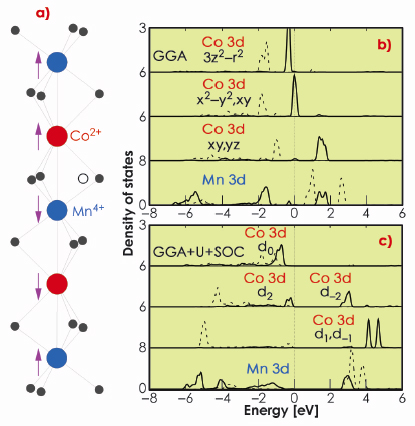- Home
- Users & Science
- Scientific Documentation
- ESRF Highlights
- ESRF Highlights 2009
- Electronic structure and magnetism
- Ising magnetism and ferroelectricity in Ca3CoMnO6
Ising magnetism and ferroelectricity in Ca3CoMnO6
Multiferroic materials, having coexisting magnetism and ferroelectricity, are of great technological and fundamental importance, given the prospect of controlling charges by applying magnetic fields and spins by voltages. Their spectacular cross-coupling effects can be explored to construct new forms of multifunctional devices [1]. Spiral magnetic order, resulting from magnetic frustration, is a common way to induce ferroelectricity. Very recently, a nonspiral magnetism-driven ferroelectric material was discovered, namely, the Ising chain magnet Ca3CoMnO6 [2]. Figure 87a shows its characteristic c-axis spin chain structure which is arranged into a hexagonal lattice in the ab plane. Along the chain alternate the octahedrally and trigonal prismatically coordinated Mn and Co ions. To understand the observed ferroelectricity, we performed ab initio electronic structure calculations, and carried out X-ray absorption spectroscopy (XAS) measurements at beamline ID08.
We computed the total energy of the material in two different ion arrangements, one with the octahedral Mn (Mnoct) and trigonal Co (Cotrig), and the other with Mntrig and Cooct. We used the generalised gradient approximation plus Hubbard U (GGA+U) calculations, also including the spin-orbit coupling (SOC). The structure having Mnoct and Cotrig was found to be much more stable, by 1.6 eV/f.u., and the Mn turns out to be in a 4+ state and the Co in a high-spin (HS) 2+ state. Figure 88 shows the Co L2,3 (upper panel) and Mn L2,3 (lower panel) XAS spectra of Ca3CoMnO6 and the references EuCoO3, CoO, LaMnO3 and MnO, as well as the simulated spectra given by full multiplet cluster model calculations. By looking closely at the energy positions and the line shapes of all the spectra, one can reliably conclude the experimental spectra match the HS Co2+trig and Mn4+oct state, thus confirming our theoretical results.
 |
|
Fig. 87: a) The characteristic |
Figure 87b shows the orbitally-resolved density of states by a GGA calculation, which indicates the narrow band character of this strongly correlated oxide. Moreover, the HS trigonal Co2+ has the nearly degenerate 3z2-r2 and (x2-y2, xy) levels. Because of the in-plane character of both the x2-y2 and xy orbitals, their strong Coulomb repulsion prevents their double occupation in the minority-spin channel. Therefore, the 3z2-r2 orbital is doubly occupied, and the minority-spin x2-y2 and xy are half filled but not apt to form a planar orbital ordering along the c-axis chain. Instead, when the spin-orbit coupling is included, the (x2-y2, xy) doublet splits into d2 and d-2, and the gain of the full spin-orbit coupling energy due to the d2 occupation (see Figure 87c) is calculated to be about 70 meV. As a result, a huge orbital magnetic moment of 1.7 µB is generated at the Co2+ site, and the spin-orbit coupling firmly fixes the parallel spin and orbital moments along the c-axis chain.
The experimentally observed ![]()
![]()
![]()
![]() magnetic structure of the Co-Mn-Co-Mn Ising spin chains may be partially due to the finite antiferromagnetic interchain couplings. An exchange striction in those
magnetic structure of the Co-Mn-Co-Mn Ising spin chains may be partially due to the finite antiferromagnetic interchain couplings. An exchange striction in those ![]()
![]()
![]()
![]() spin chains breaks the spatial inversion symmetry. Our calculations show that each spin chain has alternate short and long Co-Mn distances after a lattice relaxation. This, together with the Co2+-Mn4+ charge order, produces the observed ferroelectricity.
spin chains breaks the spatial inversion symmetry. Our calculations show that each spin chain has alternate short and long Co-Mn distances after a lattice relaxation. This, together with the Co2+-Mn4+ charge order, produces the observed ferroelectricity.
 |
|
Fig. 88: The experimental and simulated XAS spectra of Ca3CoMnO3 and the references EuCoO3, CoO, LaMnO3 and MnO. Ca3CoMnO6 turns out to have the high-spin trigonal Co2+ and octahedral Mn4+. |
We conclude that Ca3CoMnO6 has the octahedral Mn4+ and high-spin trigonal Co2+. The Co2+ has a huge orbital moment due to the trigonal crystal field, Coulomb correlation and spin-orbit coupling, and all this determines the significant Ising magnetism. The exchange striction in the ![]()
![]()
![]()
![]() spin chains and the Co2+-Mn4+ charge order lead to the ferroelectricity.
spin chains and the Co2+-Mn4+ charge order lead to the ferroelectricity.
References
[1] S.W. Cheong and M. Mostovoy, Nature Mater. 6, 13 (2007).
[2] Y.J. Choi, H.T. Yi, S. Lee, Q. Huang, V. Kiryukhin, and S.-W. Cheong, Phys. Rev. Lett. 100, 047601 (2008).
Principal publication and authors
H. Wu (a), T. Burnus (a), Z. Hu (a), C. Martin (b), A. Maignan (b), J.C. Cezar (c), A. Tanaka (d), N.B. Brookes (c), D.I. Khomskii (a) and L.H. Tjeng (a), Phys. Rev. Lett. 102, 026404 (2009).
(a) II. Physikalisches Institut, Univesität zu Köln (Germany)
(b) Laboratoire CRISMAT, Caen (France)
(c) ESRF
(d) Hiroshima University (Japan)



